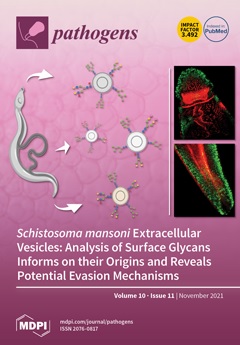Ver ítem
- xmlui.general.dspace_homeCentros e Institutos de InvestigaciónCICVyA. Centro de Investigación en Ciencias Veterinarias y AgronómicasInstituto de PatobiologíaArtículos científicosxmlui.ArtifactBrowser.ItemViewer.trail
- Inicio
- Centros e Institutos de Investigación
- CICVyA. Centro de Investigación en Ciencias Veterinarias y Agronómicas
- Instituto de Patobiología
- Artículos científicos
- Ver ítem
In Silico Survey and Characterization of Babesia microti Functional and Non-Functional Proteases
Resumen
Human babesiosis caused by the intraerythrocytic apicomplexan Babesia microti is an expanding tick-borne zoonotic disease that may cause severe symptoms and death in elderly or immunocompromised individuals. In light of an increasing resistance of B. microti to drugs, there is a lack of therapeutic alternatives. Species-specific proteases are essential for parasite survival and possible chemotherapeutic targets. However, the repertoire of proteases in B.
[ver mas...]
Human babesiosis caused by the intraerythrocytic apicomplexan Babesia microti is an expanding tick-borne zoonotic disease that may cause severe symptoms and death in elderly or immunocompromised individuals. In light of an increasing resistance of B. microti to drugs, there is a lack of therapeutic alternatives. Species-specific proteases are essential for parasite survival and possible chemotherapeutic targets. However, the repertoire of proteases in B. microti remains poorly investigated. Herein, we employed several combined bioinformatics tools and strategies to organize and identify genes encoding for the full repertoire of proteases in the B. microti genome. We identified 64 active proteases and 25 nonactive protease homologs. These proteases can be classified into cysteine (n = 28), serine (n = 21), threonine (n = 14), asparagine (n = 7), and metallopeptidases (n = 19), which, in turn, are assigned to a total of 38 peptidase families. Comparative studies between the repertoire of B. bovis and B. microti proteases revealed differences among sensu stricto and sensu lato Babesia parasites that reflect their distinct evolutionary history. Overall, this data may help direct future research towards our understanding of the biology and pathogenicity of Babesia parasites and to explore proteases as targets for developing novel therapeutic interventions.
[Cerrar]

Autor
Fuente
Pathogens 10 (11) : 1457 (2021)
Fecha
2021-11
Editorial
MDPI
ISSN
2076-0817
Documentos Relacionados
Formato
pdf
Tipo de documento
artículo
Proyectos
(ver más)
INTA/2019-PD-E5-I102-001/2019-PD-E5-I102-001/AR./Desarrollo de vacunas y tecnologías para mejorar las estrategias profilácticas y terapéuticas de las enfermedades que afectan la producción animal y la salud pública
INTA/2019-PE-E5-I109-001/2019-PE-E5-I109-001/AR./Convocatoria: Estudios para el control de enfermedades subtropicales y/o transmitidas por vectores (Tristeza Bovina, Garrapatas, Miasis, Tripanosomiasis, Lengua Azul y la
INTA/2019-PD-E5-I105-001/2019-PD-E5-I105-001/AR./Patógenos animales: su interacción con el hospedador y el medio ambiente. Impacto en productividad, ecosistemas, sanidad animal y salud pública en el marco “Una Salud”
Palabras Claves
Derechos de acceso
Abierto
 Excepto donde se diga explicitamente, este item se publica bajo la siguiente descripción: Creative Commons Attribution-NonCommercial-ShareAlike 2.5 Unported (CC BY-NC-SA 2.5)
Excepto donde se diga explicitamente, este item se publica bajo la siguiente descripción: Creative Commons Attribution-NonCommercial-ShareAlike 2.5 Unported (CC BY-NC-SA 2.5)


